 |
||
|
||
| ||
DVD-Audio playback, 24bit 192kHz format and 6.1 sound in games and movies So long awaited sound cards of the next generation from Creative, this undoubted leader on the market of multimedia solutions for PC, have finally arrived onto the market. They've got a plain name of Audigy2. The Audigy cards released last year were just a preparation for the today's triumphant procession. The mysterious words "24 bits", "higher resolution sound" and others have finally assumed material form. The Audigy2 was surely equipped with several more advanced features.  So, the Audigy2 is the only sound card for PC which does support playback of audio discs of the next generation - DVD-Audio - which can contain data in the stereo formats up to 24bit 192kHz or in the 6-channel format of 24bit 96kHz. Thus, the Audigy2 has reached the maximum data format of DVD-Audio. 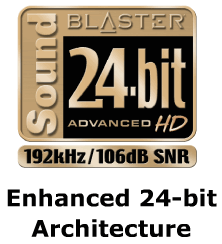 Do not mix up DVD-Audio and DVD-Video discs which can have video concerts with music. Let's take a look at the differences between the formats.
Besides, the card can reproduce a signal via the analog-outs on a 6.1 acoustic system both in movies (DolbyDigital 6.1 Surround EX) and in games (DS3D, OpenAL). Decoding is implemented by the card as well. 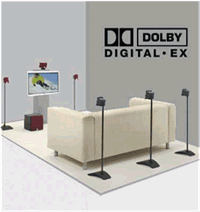 The Audigy2 conforms to the THX specification. However, this label is stuck to most systems, including those priced at $100 which are deprived of even a central channel. So don't focus much on this certification.  Gaming capabilities of the Audigy2 are on the same, high level. EAX 3.0 is fully supported and the number of hardware streams in the DirectSound and DirectSound3D is doubled - 64 against 32 of the Audigy. 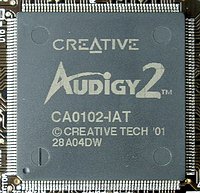 In 2002 the company is going to launch two modifications: Audigy2 and Audigy2 Platinum. The latter will have a unit which can be mounted into a 5" drive bay.  In 2003 we will see an Audigy Platinum eX which will sport an external unit in the style of Extigy, as well as an exclusive support of the ASIO2 and operation in this professional interface in the 24 bit 96 kHz mode (the junior models have ASIO1 which is fixed at 16 bit 48 kHz).  Audigy2The card made of dark textolite with gold-plated connectors looks like other cards of Creative. The Audigy2 is a little lengthier than the Audigy and has almost the same connectors. The IEEE1394 connector is onboard and a rarely used Joystick connector is located on a separate bracket. The digital multipin output of the Audigy2 is now taken away from the analog output of the center and subwoofer! But in the 6.1 mode the newly-made dedicated analog-out turns out to have 4 pins...  Drivers and utilitiesThe drivers of the Audigy2 suit for the Audigy (but compared with the unified drivers of Creative/Compaq, they do not support Live!/Live!5.1). Moreover, both cards, old and new, get along perfectly in one system, and you can easily switch between the cards in the Surround Mixer discerning them by a resource address enclosed in parentheses. Once again the designers of Creative changed the look of all utilities having regrouped the settings in new tabs and enlarged the controls. MediaSource Go! Above is a traditional pop-up line with buttons launching proprietary utilities and applications.  Press "Go!" and you will get a special program with utilities grouped in categories. Now this is called Creative MediaSource. 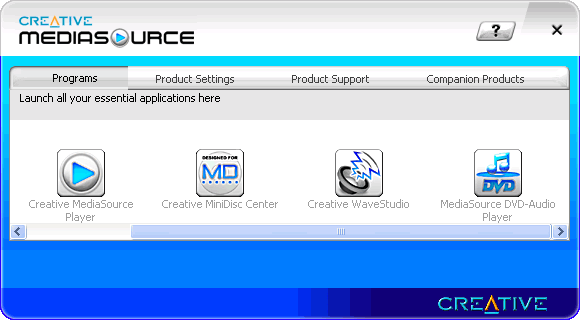 Surround Mixer The good old Surround Mixer adjusts a volume level of physical channels of the card. The bug which doesn't allow you to record from a line-in without playback monitoring is inherited from the Audigy.   Speaker settings Speaker settings are brought into a separate tab. The strong point here is a possible calibration of the speakers. In addition to a per-channel volume balance you can interchange the left and right speakers on the software level or cancel an antiphase connection. 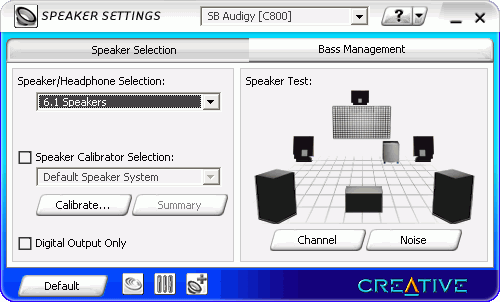 In the subwoofer channel's tab you can adjust its volume level and a crossover frequency which will have a positive effect on PC speakers deprived of low frequencies. 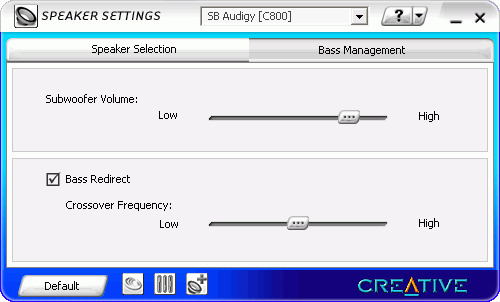 EAX AdvancedHD Console Special settings of the EAX AdvancedHD are separated. The effects haven't changed since the Audigy. 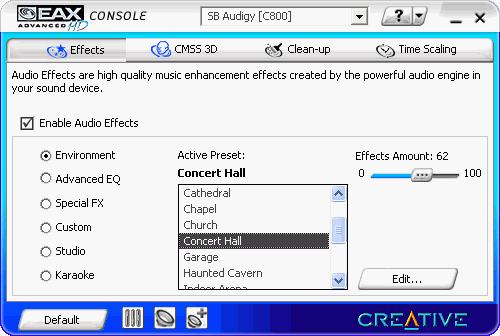 The CMSS technology (Creative Multi Speakers Surround) which distributes stereo sound in 4, 5.1 and 6.1-speaker configurations is detached from the presets, like Movie Mode, and moved into a separate category. Moreover, the CMSS 2 mode has a little of reverberation added.  Clean-up (noise reduction) can be enabled both for an external source (for recording) and for playback of noisy phonograms. 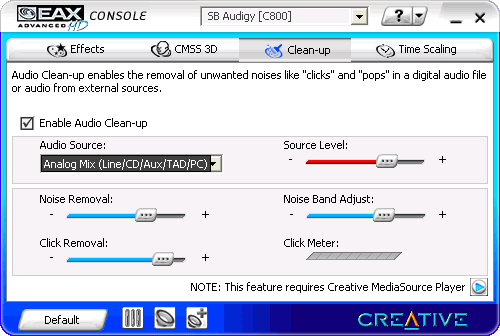 The EAX AdvancedHD can also speed up or down playback without changing the pitch (time-scaling). 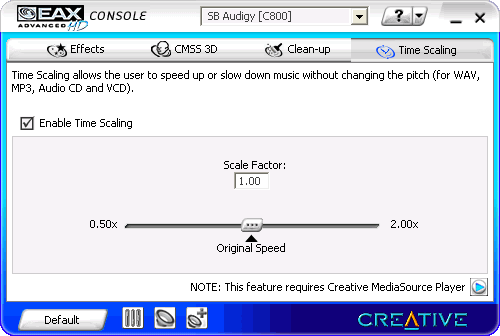 Creative Player PlayCenter is now called simply Player. The design has improved. They have added a good playlist which contains nothing, but for names of compositions. In the full-screen mode the player can create a well structured library and record all the stuff on a CD-R. Certainly, it allows grabbing CD-DA in WAV, MP3 and WMA with automatic file naming according to the CDDB Internet base.  Also, here is a cool Mini skin...  ...and Micro.  Beside various EAX features there is an SVM option which equalizes a relative volume level of files from the playlist. DolbyDigital EXUsing the DolbyDigital EX you can increase the number of channels compared with the standard 5.1 scheme. That's obvious that the support of a greater number of channels is an attempt of the manufacturer to make a user to replace its equipment first with a 6.1 system and then with a 7.1 one. Some DVD movies can have a 6.1 format supported in Dolby Digital, others in DTS ES. Audigy2 is able to decode only Dolby Digital EX 6.1 format. 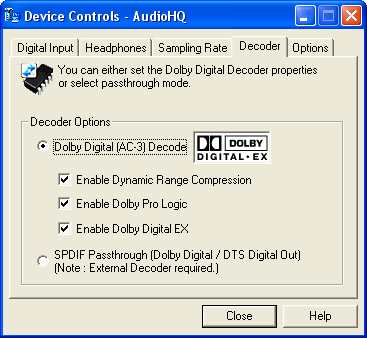 On a PC the 6.1 sound makes more sense than in movies. The central rear speaker can help gamers to get a clear idea on where a sound comes from in the rear part of the sound in every 3D shooter.  ConvertersAs you know, audio quality of any sound card depends on software and hardware components of the sound section, i.e. on one hand, it depends on quality of algorithms processing audio data on the level of drivers and DSP, and on the other hand, it depends on quality of converters and discrete components, including their mounting and layout. But the character of sound is determined exactly by converters. It's quite easy to tell apart inexpensive 1bit DACs from Philips with their smooth sound, aggressive Sigmatel codecs with a too noisy sound and dear AKM and Crystal converters with a very clear sound. This is why we pay so much attention to the codecs integrated into cards. Knowing that Creative and Sigmatel have been collaborating for a long time, I expected the STAC9460 codec which is actively promoted now for DVD-Audio. But quality of this chip didn't impress me at all when I tested the Audiotrak Prodigy192 card (with a very promising DSP VIA Envy24HT). However, Creative incorporated into the Audigy2 a very interesting 8-channel 24bit 192kHz DAC Crystal CS4382.  The Crystal trade mark which belongs to Cirrus Logic is used for a wide range of converters - from cheap AC'97 codecs for $10 sound cards to luxurious and pricey DACs designed for Hi-End and professional equipment. Nonetheless, the CS4382 DAC used here is not a cheap solution. It's 5-6 times dearer than DACs used in ordinary sound cards (according to the price data from the manufacturers' sites), and the converters are just a stair lower and have characteristics a little bit inferior to those of much more expensive top stereo Crystal DACs. Although the 4382 is a chip of the last year line, the current model 4383 has nothing new except the support for muting of rear channels. Crystal CS4382 characteristics. Dynamic range: 114 dB A - for the 24-bit mode; 97 dB A for the 16-bit one. THD (0 dB signal): 0.001% for the 24-bit mode; 0.002% for the 16-bit one. For headphones output an internal unit from the Audigy2 Platinum model has a stereo DAC from the same company - Crystal CS4392. Its converters come with the same high characteristics. In contrast to other companies, Creative doesn't save on electronic components starting from its first model of Live!Platinum and makes a digital connection between the card and the module, that is why pickups do not impact the cable. The Sigmatel STAC9721 AC'97 codec is used for servicing various internal analog connectors and a mic-in. The Audigy used the Creative CT1297 for this purpose. Both codecs are well known from the Live! cards. Like in the Audigy, the new-comer uses the Philips UDA1361 ADC. It also used on inputs of the Platinum version. Specification of the card A couple of words on figures. A lot of users do not take seriously characteristics claimed in the specifications, and it's actually be explained. Some consider that specified digital characteristics have no sense at all, which is not correct. The problem is not in figures, but in the way they are manipulated with. No secret that figures and sophisticated technical parameters are used in marketing purposes. The figures given can be obtained in nonstandard conditions, they can be incomplete or relate only to a part of the device. The more respectable the company, the more modest and realistic the characteristics. Fortunately, Creative could refrain from copying very beautiful figures from the DAC's certificate. And the specification for the Audigy2 contains the parameters measured with the AudioPrecision system.
SNR (signal to noise ratio) shows, in fact, power of noise with no signal. Coupled with 24 bits, SNR is a main marketing arm of Creative in conquering customers. In fact, the "signal-to-noise with no signal" parameter does nothing with sound quality, it reflects a volume level of noise in pauses which won't be heard at all yet at 90 dB A. In digital equipment the problem of noise is done away with, and all such characteristics like SNR=100 dB A and higher are just one more indication of a high-quality device, and it is not a main factor which determines sound quality. Actually, a noise-gate can raise SNR up to the theoretic value and even disable outputs at a certain operation threshold, but it do nothing with sound quality when a signal is applied. You can judge about sound purity by non-linear (harmonic or intermodulation) distortion coefficients and judge about how detailed the sound is by the dynamic range (applying a signal of a small amplitude to the system's input). To make the SNR test sensible we apply a zero signal with a standard triangular dithering. The spectrogram also allows estimating possible pickups from high-frequency parts or defects in filtering in power supply. Collating the spectrograms of the Audigy and Audigy2 cards, we can see that pickups are absent, and a noise spectrum has changed, though the power is near the same. A frequency response will also be a useless parameter if you don't account for the fact that a manufacturer can get it wrong. The Audigy, in spite of 24bit 96kHz supported, couldn't produce the whole frequency range in this format accurately, - it converted it into 16bit 48kHz and had a bad cut in the HF audible range (attention! it's only for the 24/96 mode). In the Audigy2 the conversion is removed and the frequency response is corrected. It would be better if Creative gave in specs the frequency response for the audible range. Luckily, it's possible with the RMAA program. Well, the Audigy2 can produce the whole range in the 24/96 mode without even a hint of any conversion and with a remarkable FR similar to that of professional cards. THD+N is a more important parameter which accounts for noise and harmonics when a 1kHz signal is applied. 0.004% means 88 dB, which provides a solid reserve of sound clearness. However, they couldn't avoid troubles completely: the second harmonic is well masked by the fundamental oscillations while the rest are more unpleasant. The spectrogram shows that the ÷to Audigy2 plays much clearly than the Audigy. So, we award the Audigy2 the title of Audigy Service Pack1. This is exactly what we expected from the Audigy a year ago. However, this time we also do have some complains. The tests results indicated that 44.1 kHz to 48 kHz unswitchable resampling is still used. RMAA measurement16bit 44kHz
16bit 48kHz
24bit 96kHz
RMAA DirectSound Sound qualityModern sound cards have rather decent quality which suffices for inexpensive computer speakers. But you still can notice a difference with multimedia wooden speakers and Hi-Fi headphones. Taking into account that the today's acoustics and sound sources are of really high quality (DVD-Audio in an increased resolution, DVD-Video with PCM and DTS, CD-DA with lossless compression, high bitrate MP3), the cards have a long way to go. Live!5.1 vs. Audigy If you remember, last year, in the review of the first version of the card, we compared sound quality of the Live!5.1 vs. Audigy using wooden speakers SVEN IHOO 5.1. That time we didn't notice a tangible difference. This time we repeated the test of Live!5.1 vs. Audigy on Microlab SOLO-1 speakers with higher-quality silk HF loudspeakers. As a reference we used a separate system with a professional sound card Lynx Two and Event 20/20 bas active monitors. Well, there is some difference. The Live!5.1 (on the Sigmatel STAC9708 codec) has a more aggressive sound with more distortions. The Audigy (on the 6-channel Philips UDA1328 DAC) has a smoother sound, but at the same time it's not so similar to the original: it should have a sharper attack and distinctness at high frequencies. So, both solutions have weak points of a different character, that is why they play on the same level. Audigy vs. Audigy2 Here we have much more difference. The Audigy2 has a brighter and more detailed sound, the stereo field is much wider than that of the Audigy. The bass part is deeper and richer. The highs are clearer and more transparent. That's a complete victory of the Audigy2! Moreover, even in the everyday work I clearly feel that the sound is improved. The difference could be perceived even with Microlab SOLO-1 speakers priced at $50. The difference got stronger when I connected the cards to the Event 20/20 bas monitors. I even decided to collate the Audigy2 with the Lynx Two with its top CS4396 converters from Crystal. But no wonder occurred. The Lynx Two got a notably better sound. Probably, the quality of the acoustic system is a bottleneck here. On the other hand, the converters mounted onto the Audigy2 came very close to the limiting capabilities of the modern mass electronic equipment. DVD-AudioDespite the same physical carrier and record format the existent popular players for DVD-Video discs (for instance, PowerDVD, WinDVD, and certainly MS WMP) are not able of playing music in high-quality modes from DVD-Audio discs. They can see only their DVD-Video compatible part which usually contains only a track in the multichannel DolbyDigital format. Luckily, Creative didn't just declare abstract compatibility with DVD-Audio like many other companies do, but included a proprietary software DVD-Audio Player into the a bundle of utilities. The player also decodes audio data from the MLP format (it's a compression of audio data without quality losses). A DVD-Audio disc can also have pictures and text, as well as a menu, which unfortunately can't be handled by this player. However, it's just a starting point, let's wait for further events. InterVideo has recently announced that the WinDVD4 will support 24/96 for DVD-Video.  The Creative DVD-Audio Player is designed exactly for the Audigy2 card. I cannot choose any other device for playback of music. Also, by request of the DVD-Audio Alliance they provided the protection from playback via a digital-out. It won't please those who prefer using converters in an external DAC or receiver. On the other hand, the sound of DVD-Audio is good enough, and we can recommend that you go with an analog-out. Besides, the analog connection provides a multichannel support in full measure. Playback of DVD-Audio requires a DVD-ROM drive of the second generation and W2K SP3 or XP SP1 operating system. You need at least a 5x read speed of the drive because of the 1.5 times greater bitrate of DVD-Audio discs compared to DVD-Video and because of possible speed-down in reading depending on location of a laser's head. We tested playback of DVD-Audio on the Creative's 5x drive under the XP SP1 and had no problems when played 6-channel tracks in the 24bit/96kHz mode. The drive just winks sometimes spooling data into the buffer. Any operations carried out simultaneously in the Windows didn't affect the playback. Now let's compare the same disc recorded in the old CD-DA format and in the DVD-Audio. The Irish band "the Corrs", pop-rock with ethno elements. "In Blue" album, 143 Records/Atlantic Recording. 16bit 44kHz stereo vs. 24bit 88kHz stereo (the maximum possible 192 kHz wasn't found here). There are not much difference in the sound. In both cases the sound is strongly compressed. But the sound in the increased resolution contains less crackle and distortions, and the stereo panorama is a little wider. The differences can be noticed both with the inexpensive Microlab SOLO-1 and rich Event 20/20 bas. Probably we could feel more difference listening to classical music which usually doesn't undergo such a tough dynamic processing. 16bit 44kHz with the CMSS effect-processor vs. 6-channel 24bit 96kHz format. For listening we used the Creative Megaworks 510D 5.1 system and as a Hi-Fi solution - SVEN Audio system: 514 (730 front) speakers with the amplifier 950 and subwoofer 620. The multichannel PCM does thrive here! The sound is really three-dimensional, lively and interesting. I don't want even to think about stereo or stereo with an effect-processor after such a pure and all-embracing panorama. The instruments are not mixed up, the sound of each is distinctive, it comes via its own channel imitating real positions of performers on the scene; the effects, so clear and intriguing, left far behind even the effect-processor of the Audigy2. And after the tests with the SVEN Audio system I felt a strong desire to throw away that noisy computer with all its speakers, then connect a DVD-Audio player to the Hi-Fi equipment and settle back in the armchair enjoying such a majestic sound... :) Alas, the new formats DVD-Audio and SACD have a weak point. Keeping to the slogan "sound quality at any cost" they don't support video playback. That is why an audiophile will have to make a choice: DVD-Video or DVD-Audio: video with PCM 16/48 stereo or 5.1 DD/DTS right now, or the highest-quality audio with a DVD-Audio player. Realizing that, the manufacturers of DVD-Audio discs often make multistandard media. They record a couple of video clips and sound in DD5.1 in the zone of compatibility with DVD-Video. SummaryHighs
Lows
Maxim Liadov (maxim@ixbt.com)
Write a comment below. No registration needed!
|
Platform · Video · Multimedia · Mobile · Other || About us & Privacy policy · Twitter · Facebook Copyright © Byrds Research & Publishing, Ltd., 1997–2011. All rights reserved. |